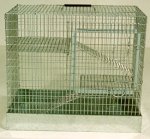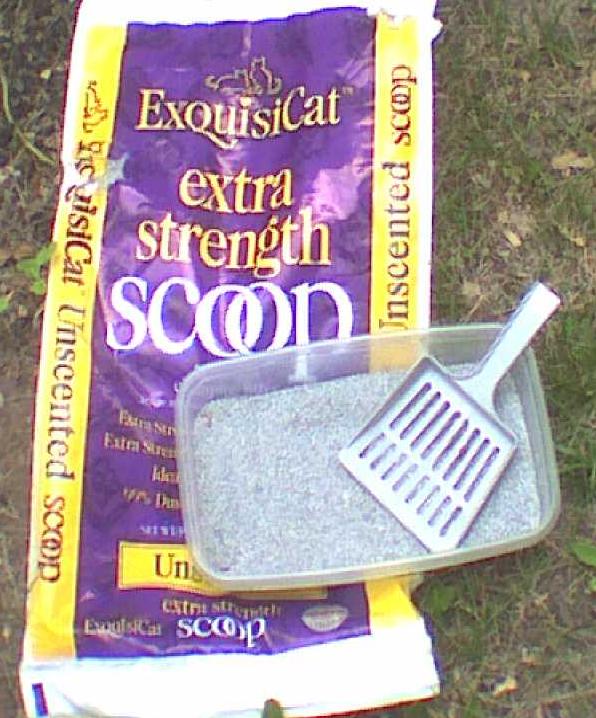Bringing home a new rat is comparable to bringing home a baby from the hospital. New rat owners are overwhelmed with questions, and confronted with aisles of supplies at pet stores, not sure what is necessary for a new rat, or what to do with the rest of the supplies! If you have found yourself confronted with this new-rat-itis, this web page will talk you through the steps necessary to create a safe environment for your newest family member.

|
For those of you planning on bringing home a new rat, the first step is to provide adequate housing. I find that many more people wind up with a rat unexpectedly, and skip the planning stage, but a proper cage is still necessary.
The cage pictured to the left is an R-640, featured at Martin's Cages. This cage would be appropriate for approximately 2 adult rats, though a keen rat owner should notice the major no-no this cage has: The second level is made of wire, which can give rats bumblefoot. This can be easily taken care of, however, by placing any sort of material over it. Rat owners have used replaceable rags, 60 cent pieces of tile (the kind you peel a sticker off the back of and slap on the floor) and in extreme cases, I recommend taking a solder gun to the cage and removing the level altogether, rather than risk the costly vet bills.
|
|
Every rat needs a source of fresh water, and a water bottle is the best way to provide it. Water dishes just don't work, trust me. Rats are playful creatures, and love to tip things over and make messes! The water bottles to the right are the All Living Things brand, and are available at Petsmart.com.
|

|
|
For the same reason, you might want to consider a food dish made specifically for small animals. My rats love to show that they're done with their food by flipping their food dish over. Other rats don't wait till it's empty, they just flip their dinner all over the cage. The dishes to the right are found on Petdiscounters.com, and are made of heavy ceramic to prevent rats from tipping them over.
|

|

|
As equally important as providing a home and fresh water and food for your rat is bedding. It's alright to line the rat's cage with newspaper (better make it several layers, they love to make nests) but if you'd rather provide something softer, there are dozens of bedding brands out there. WATCH OUT for cedar and pine...they are the devil. Many people start out with pine or cedar, thinking that its fragrance will help with any animal odors, when in fact the aromatic oils found in those two beddings can cause respiratory infections that either require a long-time use of costly antibiotics, or will result in death. The two beddings I prefer and recommend are CareFresh (pictured to the left) and Aspen. These two keep odors down much longer between cage cleanings, and won't endanger the life of your new pet.
|
|
Another item I recommend for new rat owners is a litter box. These come in all shapes, sizes and prices. My first litter box was a purple ferret litter box, made to fit in the corner of a cage. I accidentaly threw it away during a particularly needed cage cleaning, and substituted this plastic Rubbermaid container. Whatever the case, make sure it is large enough for your rat to fit its entire body in, and then fill it about an inch or two deep with your choice of kitty litter. I have found if the...results are scooped out daily, the rats are more inclined to keep using the litter box, and not to default in the corners of their cage. I had some diffiulty finding a scooper small enough to fit easily inside this container, but finally found a couple for 99 cents.
|

|

|
Now let's get to what's important: FOOD! I've heard dozens of different feeding methods, and through trial and error, here's what I've found works the best for me: I feed my rats these lab blocks as their main diet. When I worked in a pet store, we fed the rats a seed mixture, and I found it to be an incredible waste. The rats picked out the sunflower seeds and little else, eating the yummy stuff and leaving the healthy things. We wound up throwing more than half of it away over time. These lab blocks contain the perfect amount of minerals, nutrients and crude protein for the rats. Now, I would be a truly cruel person if that's all I fed my rats, so every day I make sure to give them a fresh fruit or vegetable, and of course, a yogurt drop. On a side note, I keep my rat food in a sealable container, so as to avoid raising moths.
|
|
Treats may seem like a side note, not necessary for the first armload of stuff to bring home from your trip to the pet store, but I beg to differ. Pictured to the right are yogurt drops, probably the most effective food I've found for rats. Every evening, after their dinner, I shake the box and give the rats one drop each. In a surprisingly short time, they learn to come to the sound of the box. This comes in very handy when a rat escapes or refuses to come home after an evening of romping around my room. Training rats altogether is a different story, but it's very simple, and all it really takes is patience.
|

|
Those are the necessities you will need when bringing home a new rat, but of course the job of preparing doesn't end there. There are several other things to do in order to prepare a house for its new arrival:
Place its cage in a quiet area of the house to ensure the rat isn't scared to death when it enters your house. A room filled with noise, action and bright light would send the rat scurrying for cover.
Give the rat some time before handling it. A new rat will be scared and, most likely, distrustful of new owners and settings, and the worst thing to do would be to pry the quiverinng creature from its cage to plunk it on your shoulder and parade around the house. For the first day, give the rat some space.
Always always always quarantine your rat for at least two days before introducing it to other rats. Working in a pet store, I have seen a rat go home with a family perfectly healthy, and in the next few days develop respiratory problems, usually from stress, that are transferred to other rats. Sometimes, especially if the history of the rat or the pet store is not known, the rat could have very severe respiratory infections that aren't immediately present. A quarantine is the best way to go...better safe than sorry!
To top off all this information, there are some great links to other pages on my Why Rats Make Great Pets page and my Rat Health page. This should be all you'll need to know in order to bring a new rat home. If you have any other questions, or have encountered a problem I haven't mentioned on this page, feel free to send an e-mail my way. Good luck with your new rat!








